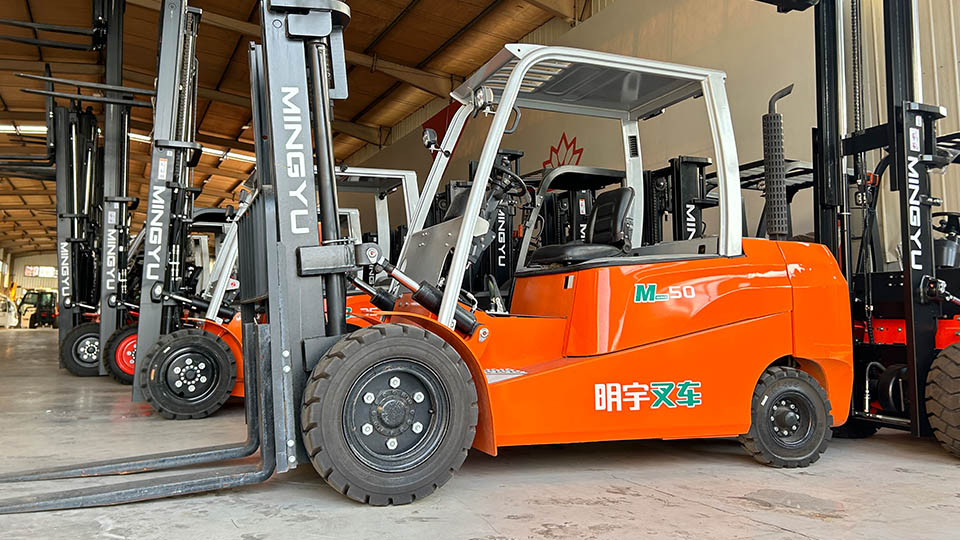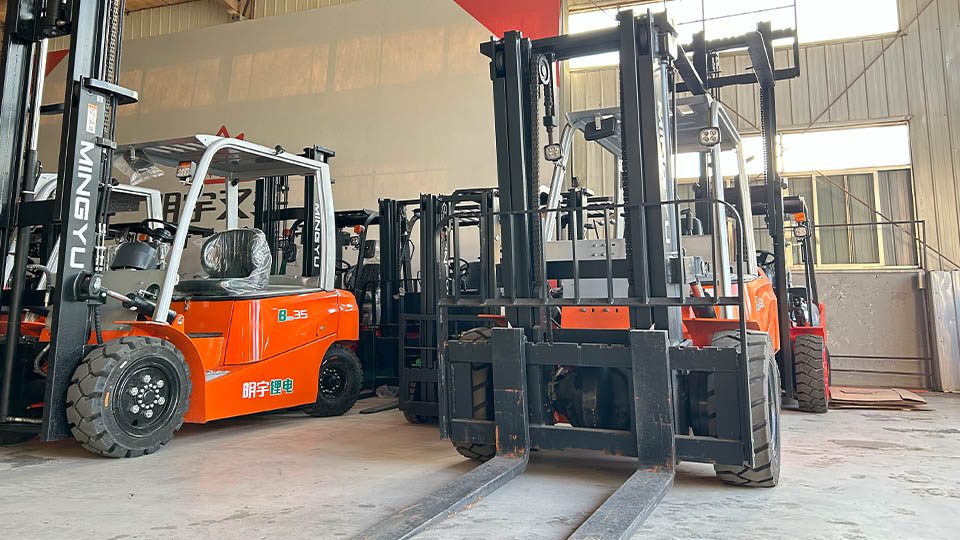
Do Electric Forklifts Have a Clutch? Unraveling the Drivetrain of Modern Material Handling
Abstract: The term "clutch" is universally associated with internal combustion (IC) engine vehicles, facilitating the engagement and disengagement of power from the engine to the transmission. This technical article addresses a frequently asked question regarding electric forklifts: Do they incorporate a clutch mechanism? By delving into the fundamental differences in drivetrain architecture between electric and IC forklifts, this article will explain why traditional clutches are absent in electric models. It will explore the roles of electric motors, power electronics, and various transmission types (or lack thereof) in electric forklifts, providing a comprehensive understanding of how these machines achieve seamless and controlled power delivery without the need for a clutch.
1. Introduction
The ubiquity of the clutch concept in automotive and traditional industrial vehicles (IC engine).
The rise of electric forklifts as a dominant force in material handling.
The core question: Does this "clutch" mechanism translate to electric powertrains?
Thesis statement: No, electric forklifts, by their very nature, do not require or incorporate a traditional clutch mechanism due to the inherent characteristics of electric motors and their control systems.
2. Understanding the Traditional Clutch in Internal Combustion (IC) Forklifts
Purpose of the Clutch:
Engine Disengagement/Engagement: To connect/disconnect the engine from the transmission.
Smooth Starting: To allow the engine to spin up to an operating RPM while the vehicle is stationary, then gradually engage the transmission to prevent stalling and provide smooth acceleration.
Gear Shifting (Manual Transmissions): To temporarily interrupt power flow during manual gear changes to prevent damage to gears.
Neutral Operation: To allow the engine to idle without transmitting power to the wheels.
How a Friction Clutch Works:
Explain the pressure plate, friction disc (clutch disc), flywheel, and release bearing.
Briefly describe the process of engaging and disengaging.
Types of Transmissions in IC Forklifts:
Manual Transmissions: Directly utilize a friction clutch. (Less common in modern forklifts)
Torque Converter (Automatic Transmissions): While not a traditional friction clutch, the torque converter serves a similar function of allowing engine idling while the vehicle is stationary and providing smooth power transfer. It acts as a fluid coupling. Briefly explain its principle (impeller, stator, turbine).
3. The Drivetrain of an Electric Forklift: A Fundamentally Different Approach
3.1. The Electric Motor: The Heart of the System
Direct Drive Capability: Unlike an IC engine, an electric motor can produce maximum torque from zero RPM. This is the single most critical reason why a clutch is not needed.
Instantaneous Torque Control: Electric motors can be precisely controlled to deliver exactly the required amount of torque, instantaneously.
Types of Electric Motors in Forklifts:
DC Motors (Older models): Brushed and Brushless (BLDC). Briefly mention their characteristics (torque, efficiency).
AC Motors (Modern standard): Induction motors (asynchronous) and Synchronous motors (e.g., Permanent Magnet Synchronous Motors - PMSM).
Advantages of AC Motors: Higher efficiency, compact size, less maintenance (no brushes), excellent torque control, wider speed range. Predominant in modern electric forklifts.
Regenerative Braking: How electric motors can convert kinetic energy back into electrical energy, acting as a brake and recharging the battery. This feature eliminates the need for separate braking mechanisms for fine speed control often handled by engine braking in IC vehicles.
3.2. Power Electronics: The Brain Behind the Control
Motor Controllers (Inverters/VFDs - Variable Frequency Drives):
Explain their function: converting DC battery power into variable frequency AC power (for AC motors) or precisely controlled DC power (for DC motors).
Role in Torque and Speed Control: How the controller precisely manages the voltage and frequency (for AC) or current (for DC) supplied to the motor, directly controlling its speed and torque output. This direct and precise control eliminates the need for a clutch to manage engine RPM relative to vehicle speed.
Smooth Start-up: The controller ramps up the motor's power seamlessly, providing a smooth and controlled acceleration from a standstill, much more effectively than a friction clutch.
Direction Reversal: The controller can instantly reverse the direction of current flow (for DC motors) or phase sequence (for AC motors) to reverse the motor's rotation, eliminating the need for complex multi-gear transmissions for forward/reverse.
3.3. Transmissions in Electric Forklifts (or the Lack Thereof)
Single-Speed Reductions: Most electric forklifts utilize very simple, single-speed reduction gears. The electric motor directly drives the differential (or individual wheel motors in some designs) through a fixed gear ratio.
No Multi-Gear Transmissions: Because the electric motor can produce full torque from zero RPM and maintain high torque across a wide speed range, there is no need for multiple gears to keep the "engine" in its optimal power band.
Direct Drive Systems: In some advanced designs, particularly with multiple motors (e.g., one per drive wheel), there might be no transmission at all, with the motor directly coupled to the wheel, further simplifying the drivetrain.
Absence of Clutch Housing: Physically, there is no space for a clutch housing or associated mechanisms in an electric forklift's powertrain.
4. Why the Clutch is Obsolete in Electric Forklifts

Instantaneous Torque at Zero RPM: The core reason. No need to slip a clutch to get the "engine" up to speed before engaging the drive.
Precise Electronic Control: The motor controller provides far superior and smoother control over power delivery than any mechanical clutch.
No Stalling: Electric motors cannot "stall" in the way an IC engine can. If overloaded, they will simply draw more current (until thermal or current limits are reached) or stop, but they don't have an idle speed that needs to be maintained.
Simplified Drivetrain: The absence of a clutch and multi-speed transmission significantly reduces the complexity, weight, and maintenance requirements of the electric forklift's drivetrain. Fewer moving parts mean higher reliability and lower running costs.
Regenerative Braking: The ability of the motor to act as a brake provides precise speed control and contributes to battery life, eliminating the need for clutch-like maneuvers for deceleration.
5. Operational Implications for Operators
Simplified Operation: No clutch pedal, no gear shifting (in most cases). This leads to easier operation, reduced operator fatigue, and a shorter learning curve.
Smooth Acceleration and Deceleration: The seamless power delivery results in smoother starts, stops, and direction changes, which is beneficial for load stability and reducing wear on components.
Precise Inching and Creep Speed: Electric forklifts excel at precise, low-speed maneuvers due to the fine control offered by the motor controller, often superior to IC forklifts relying on torque converters.
Enhanced Safety: Fewer components to wear out, no risk of stalling, and intuitive controls contribute to a safer operating environment.
6. Future Trends and Advanced Electric Drivetrains
Individual Wheel Motors: Increasingly, advanced electric forklifts are moving towards independent electric motors for each drive wheel, further simplifying or eliminating traditional axles and differentials, and enhancing maneuverability.
Integrated Motor/Controller Units: Miniaturization and integration are leading to more compact and efficient motor and controller units.
Advanced Control Algorithms: Continued development of control software will further optimize power delivery, energy efficiency, and operational smoothness.

No Reintroduction of a Clutch: The fundamental principles of electric motors make a traditional clutch redundant; future advancements will continue to build upon this simplicity.
7. Conclusion
Reiterate the definitive answer: No, electric forklifts do not have a traditional clutch.
Summarize the core reasons: instantaneous torque of electric motors, precise electronic control by motor controllers, and the resulting simplified drivetrain.
Emphasize the benefits of this design: simplified operation, enhanced control, improved energy efficiency, lower maintenance, and a cleaner, quieter operation.
Conclude that the absence of a clutch is not a limitation but a defining advantage of electric forklift technology, contributing to their efficiency, usability, and environmental benefits in modern material handling.
References (Optional but Recommended):
Technical specifications from leading electric forklift manufacturers (e.g., Toyota Material Handling, KION Group, Hyster-Yale, Crown Equipment).
Textbooks or academic papers on electric motor control and power electronics.
Industry standards related to forklift design and safety.
Name: selena
Mobile:+86-13176910558
Tel:+86-0535-2090977
Whatsapp:8613181602336
Email:vip@mingyuforklift.com
Add:Xiaqiu Town, Laizhou, Yantai City, Shandong Province, China